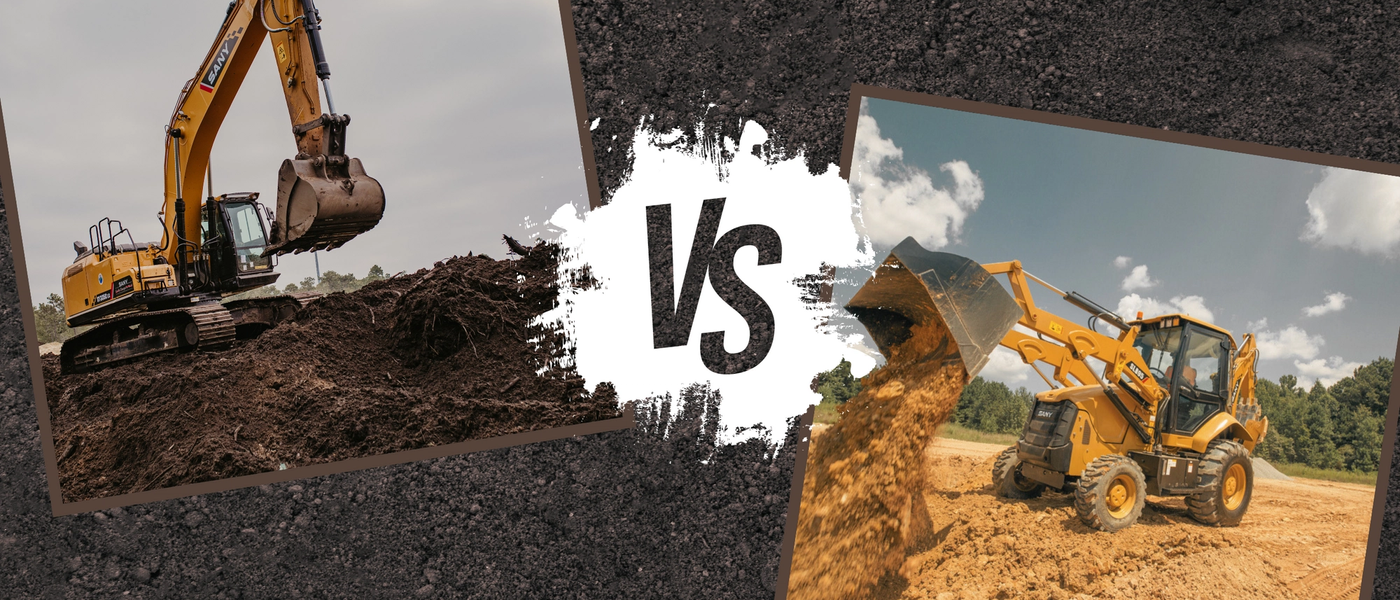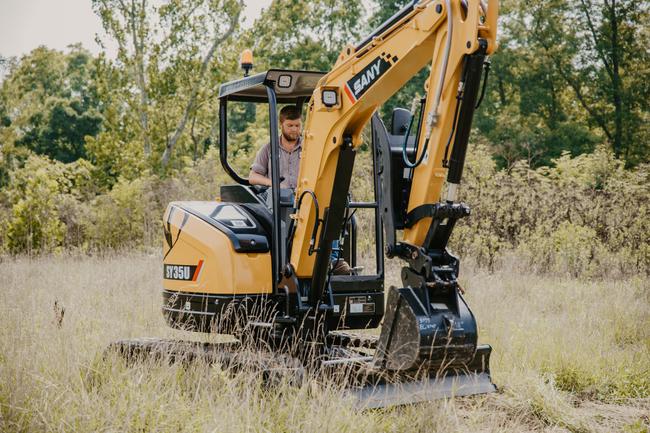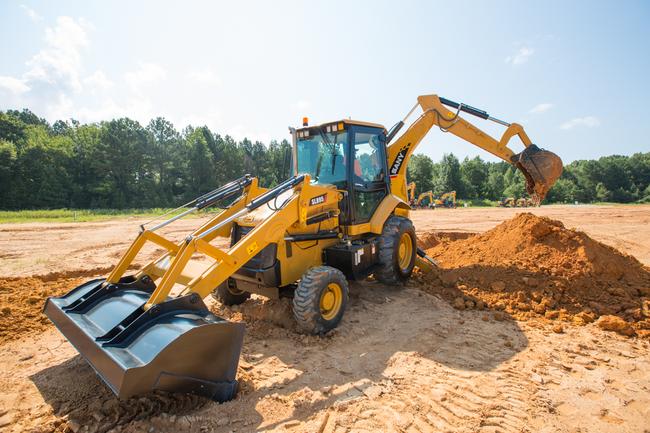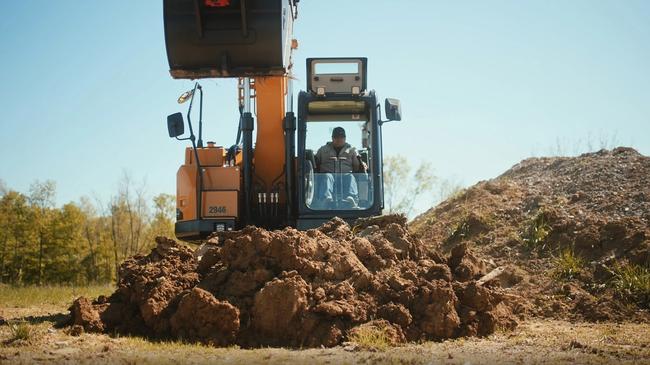Excavator vs. Backhoe: Understanding the Differences and Choosing the Right Machine
- Machine Comparisons

When tackling a construction project, one of the decisions you'll face is choosing the right machinery. In earth-moving equipment, two names often come up: excavators and backhoes.
At first glance, they might seem interchangeable, but these machines have distinct features and capabilities that suit different project needs. This choice isn't just about preference, efficiency, cost-effectiveness, and getting the job done right.
This is where we step in. We will dive into the excavator vs. backhoe debate. We’ll explore what sets these machines apart, their strengths and weaknesses, and the scenarios where each shines. Whether you’re a seasoned contractor or new to the game, understanding these differences help make an informed decision that aligns with your project's requirements. Let’s clear the confusion and help you pick the champion for your next project.
An excavator is a pivotal machine in heavy construction, renowned for its significant role in digging, earthmoving, and lifting operations. This powerful equipment is identifiable by its distinct features and is utilized in various construction scenarios.
Core Components
- Boom, Stick, and Bucket: The boom (the upper), the stick (the lower part), and the bucket work together for digging and lifting tasks.
- Cab: Positioned on a rotating platform, the cab houses the operator and provides a 360-degree rotational ability, enhancing the machine's operational range.
- Tracks or Wheels: Depending on the model, excavators come with either tracks for stability on uneven terrains or wheels for easier mobility on hard surfaces.
Excavator Capabilities
Excavators are primarily used for extensive digging tasks, such as creating trenches, holes, and foundations for buildings.
- Material Handling and Lifting: Various attachments enable excavators to perform diverse tasks, including lifting heavy materials and objects.
- Demolition Projects: Larger excavators can demolish structures, showcasing their strength and power.
- Mining and Large-Scale Construction: In mining operations, excavators move earth and extract materials.

What is a backhoe?
A backhoe, a staple in urban and rural construction projects, stands out as a versatile and multifunctional machine. It's excavating equipment with a distinctive composition and wide applications.
Distinct Design of a Backhoe
- A backhoe is unique in its dual-functionality, featuring a two-sided design. It combines a digging arm, similar to an excavator, at the rear, known as the backhoe, and a loader bucket at the front, making it adept at handling a range of tasks.
- Notably smaller in size and versatile, backhoes are well-suited for tasks in more confined spaces. Their compact build enhances their agility, making them a practical choice for various applications where maneuverability is crucial.
Backhoe Operating Mechanism
- In a backhoe, the cab and controls are central to its operation. The cab allows the operator to control both the backhoe and loader functions. Unlike an excavator's cab, it typically doesn't rotate, simplifying the operation while limiting the range of motion.
- The mobility of backhoes is enhanced by their wheeled design. This feature facilitates easier and faster transportation between job sites and is particularly advantageous for projects in urban settings, where quick and efficient movement is often necessary.
What a Backhoe is Used for
- Digging and Excavation: Backhoes are commonly used for digging trenches for utilities, laying pipes, or installing underground cables.
- Loading and Material Handling: The front loader bucket is perfect for moving large quantities of material, such as dirt, gravel, or snow.
- Landscaping and Agricultural Work: Their size and agility make backhoes a popular choice in landscaping and agricultural tasks, from tree planting to clearing land.
- Small-Scale Construction and Demolition: In urban construction and small-scale demolition projects, the backhoe's dual functionality and mobility offer a significant advantage.

Major Differences Between Excavators and Backhoes
Understanding the differences between excavators and backhoes is crucial when deciding which is best suited for a particular project. These differences span across various aspects, including size, design, mobility, functionality, operational capacity, and range of motion.
Size and Design
- Excavators: Typically larger and heavier (but they also come in mini sizes), excavators have a design that allows for a full 360-degree rotation. This feature enhances their ability to work in various directions without needing to move the entire machine.
- Backhoes: Generally smaller and more compact, backhoes feature a dual-function design with a digging arm on one end and a loader bucket on the front. Their design restricts them to less than 360 degrees of rotation, usually around 200 degrees.
Mobility
- Excavators: Often equipped with tracks, excavators are more stable on uneven terrain but are less mobile in terms of transport from one site to another.
- Backhoes: Typically wheeled, backhoes are more mobile and versatile, easily moving around a site and between different locations.
Functionality and Operational Capacity
- Excavators: With a primary focus on digging and heavy lifting, excavators are ideal for large-scale construction projects, deep excavation, heavy material lifting, and demolition. Their extended reach and depth capabilities allow them to handle larger, heavier tasks more efficiently.
- Backhoes: The backhoe is a multi-purpose machine, adept at smaller-scale digging, trenching, back-filling, and material handling. The additional loader bucket makes them suitable for light transportation and loading tasks.
Range of Motion
- Excavators: The ability to rotate 360 degrees gives excavators an edge when space is limited or the machine needs to work in multiple directions from a single point.
- Backhoes: While backhoes can't rotate fully, their dual-end functionality offers versatility in various tasks, making them particularly useful in urban construction, small demolitions, and landscaping.
Real-Life Example: SANY SLB95 Backhoe vs a SANY SY80U Excavator
Let’s put two SANY machines head-to-head so that you can get a good idea of the similarities and differences between the SANY SLB95 backhoe and the SANY SY80U excavator.
| SLB95 Backhoe | SY80U Excavator | |
|---|---|---|
| Operating Weight | 16,623 lbs | 19,401 lbs |
| Net Horsepower | 95 hp @ 2,200 rpm | 66.4 hp |
| Cab Option | ✔️ | ✔️ |
| Canopy Option | ✔️ | - |
| Loader Bucket Capacity | 1.3 yd 3 | - |
| Excavator Bucket Capacity | .032 yd 3 | - |
| Digging Depth | 14'3" | 14'10" |
| Max Reach | 18'7" | 23'4" |
| Dump Clearance | 8'10" | - |
| Dump Height | - | 17'10" |
| Wheel Option | ✔️ | - |
| Track Option | - | ✔️ |
| Transport Dimensions | 23'4" x 7'6" x 12'3" | 23' x 7'3" x 8'5" |
| Hydraulic System | Load Sensing with Pilot Controls | Load Sensing with Pilot Controls |
| Fuel Capacity and Efficiency | 37 gallons | 26.4 gal |
Pros and Cons of Excavators
Excavators are powerful machines widely used in various construction scenarios, but like any equipment, they have advantages and limitations. Knowing these can help determine when an excavator is ideal for your project.
Advantages of Using Excavators
- Powerful digging capability is a hallmark of excavators. They excel in digging deep trenches, foundations, and holes, making them indispensable in major construction and mining operations.
- Excavators' versatility with attachments enhances their utility significantly. They can be outfitted with a variety of attachments for tasks beyond digging, including breaking, grappling, and cutting, allowing for a wide range of applications.
- Known for their high efficiency in large spaces, excavators have the ability to rotate 360 degrees. This feature enables them to work effectively in large, open areas without the need for repositioning the entire machine.
- The exceptional lifting capacity of larger excavator models is crucial in construction and demolition projects. They can handle lifting heavy materials, playing a key role in various heavy-duty tasks.
Limitations of Excavators
- When it comes to working in small spaces, standard excavators may not be the best fit. Their size and design can hinder maneuverability, making them less ideal for confined spaces or urban environments.
- Mobility issues can arise with excavators, particularly those with tracks. They are not as easily transported between job sites as other construction vehicles, often necessitating additional transport logistics.
- The higher operational costs associated with excavators should be considered. The initial investment is significant, and costs like maintenance and fuel, particularly for larger models, can add up.

Pros and Cons of Backhoes
Backhoes are versatile and commonly used machines in construction, but like all equipment, they have their specific strengths and weaknesses. Understanding these will help you determine if a backhoe is the right choice for your project.
Advantages of Using Backhoes
- The versatility in function of backhoes is a key feature. Their dual-functionality, with a digging arm on one end and a loader bucket on the other, equips them for a wide range of tasks, making them highly adaptable for different kinds of work.
- Backhoes are ideal for medium-sized projects due to their balance of power and size. They fit perfectly into medium-scale construction work, utility projects, and landscaping, offering a good blend of capability and manageability.
- The mobility of backhoes, often equipped with wheels, enables easy movement around a job site and between different locations. This feature is especially beneficial in urban and residential areas where maneuverability is crucial.
- Known for their ease of operation, backhoes offer a less complex alternative to larger machinery. This ease makes them a preferred choice for a diverse range of operators, simplifying tasks across various job sites.
Limitations of Backhoes
- Limited digging depth and power are aspects to consider with backhoes. They are versatile but can't match larger excavators' digging capabilities, which could be crucial for extensive excavation projects.
- Backhoes may be less efficient than larger excavators or heavy-duty machinery in large open spaces. Their smaller size and lower power can be limiting factors in big construction sites where extensive coverage and power are needed.
- When it comes to stability in rough terrain, backhoes might fall short compared to tracked excavators. Their design is less suited for rough or unstable ground where stability and strong traction are essential.
- Although backhoes can handle lifting tasks, their lifting capacity typically doesn't reach the levels provided by larger excavators or machines specifically designed for heavy lifting.

Selecting the Right Machine for Your Project
Choosing between an excavator and a backhoe is a decision that hinges on several factors related to your project's unique requirements. Here are some key considerations to guide you in selecting the machine that aligns best with your project's needs:
Assessing Project Scale and Scope
- When considering the size of the project, it's important to align the machinery with the project's demands. With its power and reach, an excavator is well-suited for larger projects involving extensive excavation or heavy lifting. On the flip side, backhoes, with their versatility, are more fitting for medium-scale projects where various tasks need to be handled.
- The depth of excavation required is a critical factor in choosing between an excavator and a backhoe. For projects necessitating deep digging, excavators are the go-to choice due to their superior digging depth capabilities, making them ideal for significant construction and groundwork.
Evaluating Working Conditions
- When assessing the terrain and space of your job site, choosing equipment that fits the environment is essential. Thanks to their stability and robust build, excavators are the preferred choice for navigating rough and uneven terrain. In contrast, backhoes, with their more compact design, excel in urban settings or confined spaces where maneuverability is a priority.
- The mobility needs of a project are also crucial in determining the right machine. For jobs that necessitate frequent transitions between different sites or require moving around within a large site, the mobility offered by a backhoe is advantageous. Its wheeled design allows for easier and quicker transportation, making it a practical choice for projects requiring dynamic movement.
Budget Considerations
- Consider the initial investment and ongoing costs. Weigh the cost of renting or purchasing the equipment against your project budget. Excavators generally have higher upfront and operational costs compared to backhoes.
- Decide whether renting or buying is more cost-effective based on the project duration and future equipment needs.
Specific Tasks and Equipment Versatility
- Think about the range of tasks needed for your project. If you need a machine for both digging and loading, a backhoe's dual functionality might be ideal. An excavator would be more suitable for specialized tasks like heavy lifting or extensive earthmoving.
- Consider the types of attachments you'll need. Excavators offer a wider range of specialized attachments, expanding their utility for various tasks.
Considerations for Renting vs. Buying
When adding a backhoe or an excavator to your fleet, the decision to rent or buy might not always be clear-cut. This choice should be informed by various factors, ranging from financial considerations to the frequency of use.
Financial Investment and Usage Frequency
Renting can be more cost-effective if you need the equipment for a short-term project. However, purchasing may be more economical for frequent and ongoing use in the long run.
Buying heavy equipment requires a significant upfront investment, not just in purchasing but also in maintenance and storage. Renting can be a more manageable option for those with budget limitations.
Maintenance and Upkeep
Owning a machine means taking on the responsibility of its maintenance and repairs, which can add up over time. Rental companies, like Newman Tractor, typically handle the maintenance of their equipment, reducing the burden on the renter.
Renting provides access to the latest models with advanced features, ensuring you use efficient and up-to-date equipment.
Project-Specific Needs
The flexibility of renting allows you to choose equipment that fits the specific needs of each project, whereas buying limits you to the capabilities of the equipment you own.
Renting from a reliable provider like Newman Tractor means you can access a wide range of equipment options, ensuring you always have the right tool for the job.
Still not sure?
We can provide valuable advice on renting or buying based on your project's scope, duration, and budget.
Whether you rent or buy, it’s crucial to consider how the decision aligns with your project’s demands and financial planning. We’re happy to help you confidently choose the best route for your equipment needs, ensuring your projects are completed efficiently and effectively.
Conclusion: Which is better?
It depends on the job. The specific requirements of your project should guide the decision between these two types of machinery. Factors such as the project's scale, the nature of the work, space constraints, and mobility needs play a crucial role in determining the most suitable equipment.
Choosing the right machine will ensure that you're not only completing the task at hand effectively but also maximizing your resources and ensuring the safety of your workforce. With options to rent or buy from trusted dealers like Newman Tractor, you can choose the best equipment solution for every unique project challenge.
